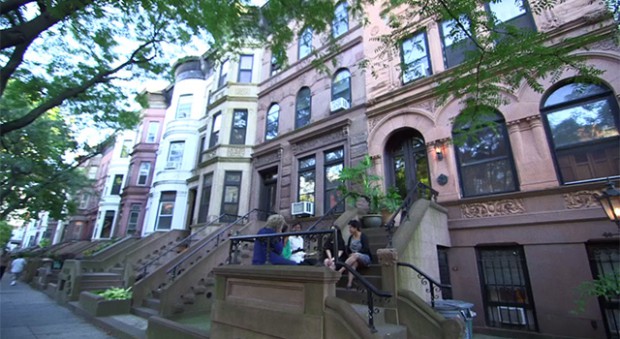Like many of Suzanne Lacy’s works, tomorrow’s performance—Creative Time’s largest undertaking to date—aims to get widespread attention on the issues of a local marginalized community. “Between the Door and the Street” enlists around 350 activists, mostly female, to stage small conversations on city stoops about issues of class and labor inequality. So it seems fitting that the project has already opened a discussion about a perennial activist problem: volunteers want to get paid.
Participant Leina Bocar and two other anonymous performers have authored an open letter to Lacy and Creative Time, asking for payment and “childcare options” for their participation. They’ve gathered signatures of solidarity from thirty academics and groups like W.A.G.E, Strike Debt, and Arts and Labor. An excerpt:
We believe that assuming and relying on free/unpaid contributions of our time for your project continues to perpetuate a standard of capitalist economy that systematically underpays and disenfranchises us, and devalues our time, our bodies, our energies, our histories and our intellects through tactics such as “professionalization.” “volunteerism” and more. This is a mainstream standard that has never worked for us, and does not serve us now.
That may sound extreme, given that the performance takes place within all of two hours, and that Lacy’s performances typically serve participants (like Oakland teens or older female activists) with free national media attention. That’s a good thing.
On the other hand, Bocar reminds me that, like a protest, even a two hour performance requires advance planning, time, and knowledge. “It’s more than just a one day commitment,” Bocar told me. She says she’s arrived at 1:30 to check in, attended a two-hour rehearsal, a three or four hour meeting with her group, and has done hours of research on the talking points for the piece. The prompts include subjects like why women earn less than men, and how working class women deal with childcare. “Its a gesture to talk about labor inequality, but we’re doing it for free,” Bocar added.
And if the prompts are designed to boost awareness of activists’ issues, then poverty is bound to come up. “It’s because I’ve spent two years of my life working for free for Occupy, coordinating, making banners, holding reading groups,” Bocar told me, “… it’s because I’ve given so much of my time that I’m more aware that this is work. That was a labor of love. I’m older now, I’m thirty-three. To now do this for free for a major institution … it’s unacceptable.”
“We’re performers,” she said. “If they’re paying the production people, the curators, and Creative Time’s staff, they also need to pay the 350 people who are making this happen.” Bocar says a few activists seemed to share her feeling but “were reluctant [to bring up the wage issue] because of institutional connections. One’s a director of a major nonprofit. I get the sense that some people don’t want to rock the boat.”
In response, Creative Time and the Brooklyn Museum issued a joint statement:
Creative Time and the Brooklyn Museum appreciate the concerns voiced in the open letter. In fact, Suzanne Lacy’s Between the Door and the Street deals with issues of gender justice, including labor, head on. The participants are social activists who were invited to use the project as a platform to advance their work and strengthen their networks through conversations that give voice to restaurant workers, nannies, reproductive-rights proponents, and numerous others. Like much political activism, this project is built upon volunteerism. And as with so much of Lacy’s work, its goal is to promote the cause of social justice.
Creative Time and the Museum have long histories of supporting artists and providing forums for open dialogue around these and other issues. We look forward to continuing the conversation.
Bocar was careful to note that it’s a delicate situation because, like many participants, she respects and shares similar interests with Lacy and Creative Time. “I’m speaking up because I am a feminist and an artist who cares about labor and gender inequality,” she said. “I have a lot of respect for Suzanne Lacy’s artwork, [Creative Time Chief Curator] Nato Thompson and Creative Time’s programming,” adding that she’s “in no way attacking Lacy or Creative Time … I am only speaking for myself and not the other participants.”
Update: Nato Thompson, Creative Time’s chief curator, wrote in to add the following:
It is true that the more-than 350 activists participating in the performance by volunteering their time to discuss issues of gender justice are not being paid. Here is a list of these amazing folks.Many are doing it because they believe in the opportunity of having a public cross-race, cross-class discussion. It’s going to be amazing and many are excited about how wild and fun this new public form of politics is going to be. Those that didn’t see it valuable to their work didn’t participate. I think this is radically different than artists not being paid to participate in museum shows. I am very aware that artists are asked to do things and told they will be paid in social capital. I find that tendency revolting and wrong. This is not a case of that. It is an important nuance that needs to be teased out. There are many women who are being paid to work on this project and we are very aware that the road to equity must address labor and rights and childcare. Yes. Of course. But the activists specifically are volunteering because they believe it furthers their social justice agenda.



Comments on this entry are closed.